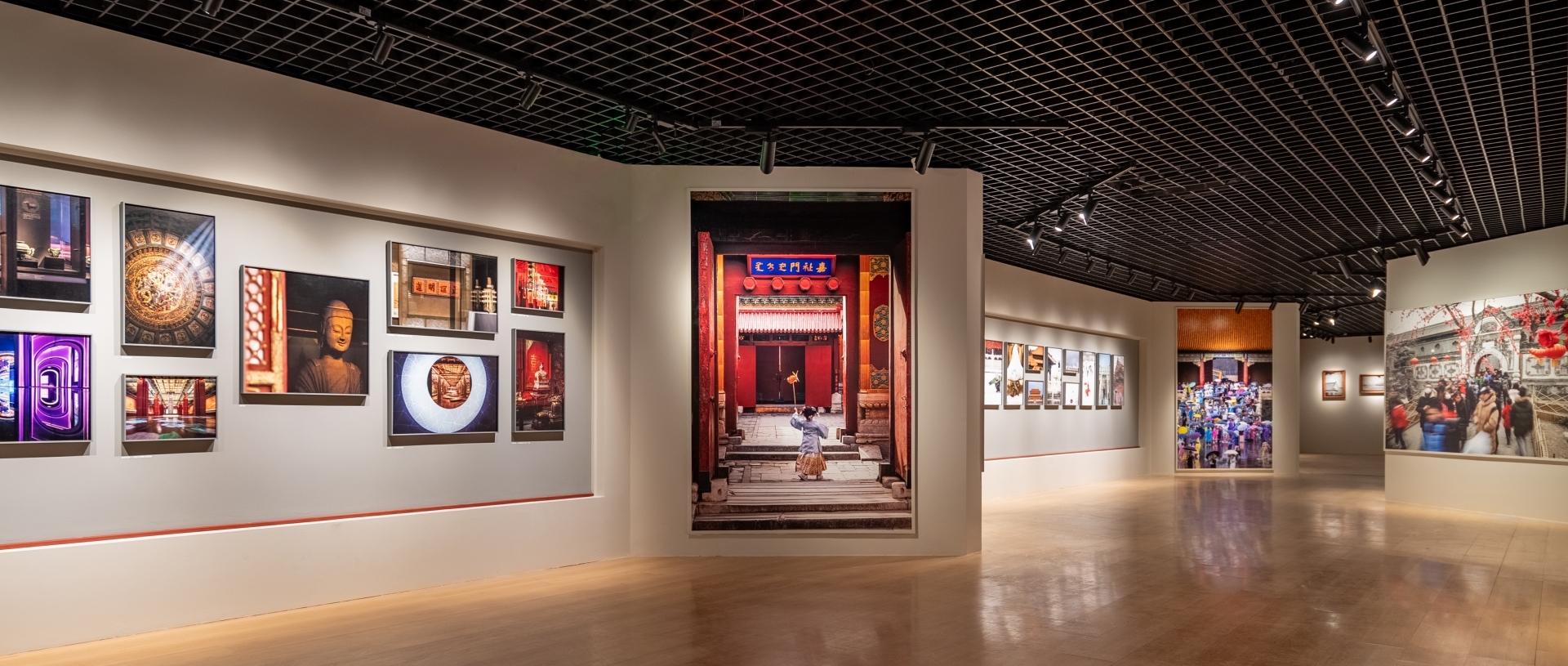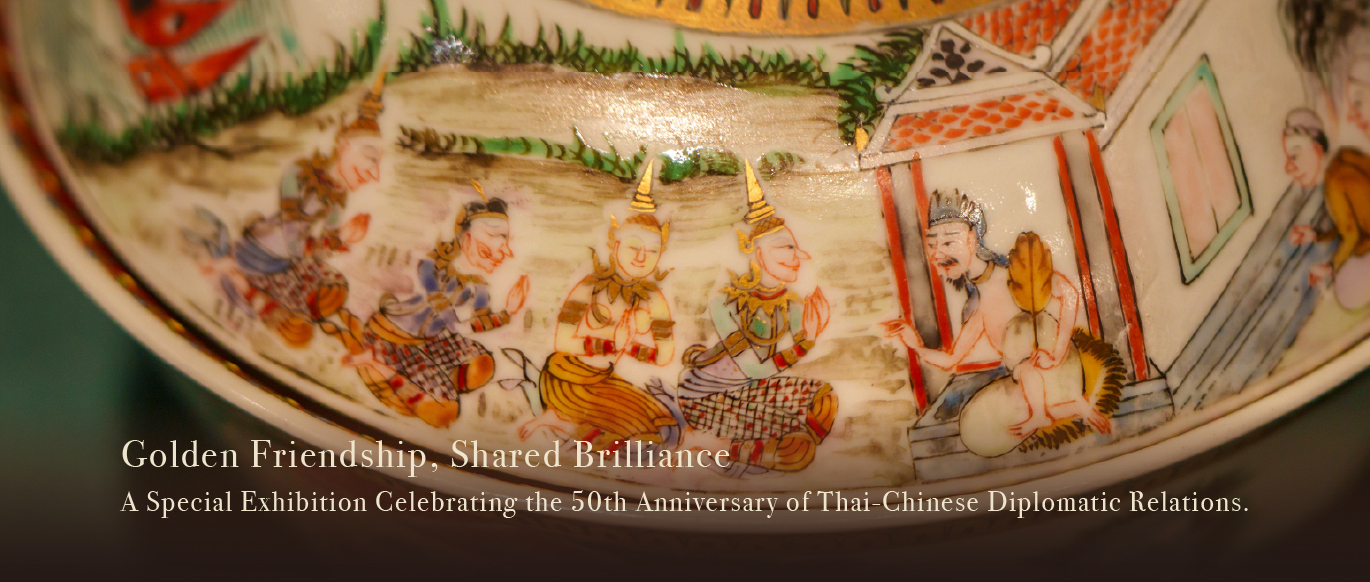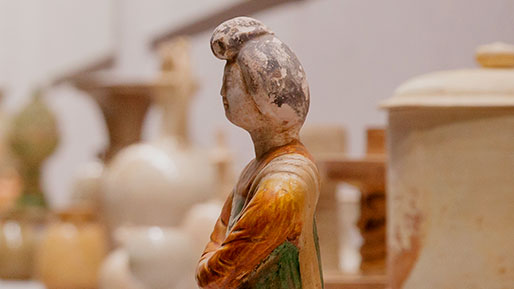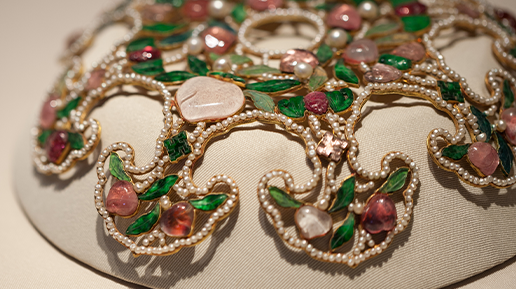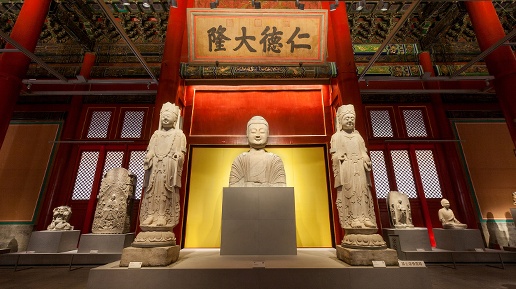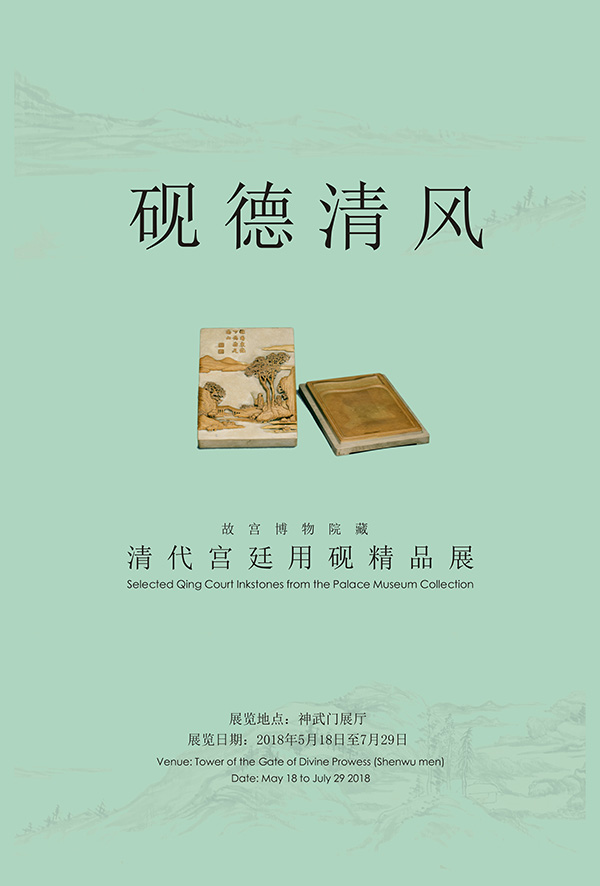
Since ancient times, Chinese calligraphers have utilized brushes, ink, paper, and inkstones as essential writing accoutrements in their studios. These tools have undergone various stages of use and development throughout China's dynastic history; they represent the means by which Chinese culture has been transmitted and the scholarly foundation of the Confucian culture of East Asia. This exhibition focuses on one of these essentials with a range of inkstones from the collection of the Palace Museum.
The Palace Museum currently has over 3,000 inkstones used by the imperial court during the Qing dynasty (1644–1911). These inkstones were produced primarily by the workshops of the Imperial Household Department and by other workshops throughout the empire during the Kangxi (1662–1722), Yongzheng (1723–1735), and Qianlong (1736–1795) reigns; a smaller proportion of the inkstones were made during the Jiaqing (1796–1820), Daoguang (1821–1850), Tongzhi (1862–1873), and Guangxu (1875–1908) reigns. Many of these are found listed in the Inkstone Catalogue of the Western Qing (Xiqing yanpu), which includes several dozen pieces in this Museum’s collection and almost a hundred currently housed in Taipei. Other pieces listed in that catalogue have been acquired by other museums in China or around the world.

Most of the inkstones in the Museum’s collection were fashioned from the finest quality jade, clay (dengni), and purple stone (zishi) or a variety of prized stones known generally by the region in which they were quarried such as Songhua stone (Songhua shi), Duan stone (Duan shi), and She stone (She shi). Having been commissioned by the imperial treasury, these articles used by the court were made by the most skilled artisans with materials of the highest quality. Some of the inkstones were made directly by artisans in the imperial workshops specializing in inkstones, gold and jade, copper, and enamel while others were produced according to imperial designs by authorized workshops throughout the empire. Those made in the court’s workshops are typically matched with boxes made with niuyou stone, black lacquer with gold outlining, tortoise shell, gourd, and zitan wood with jade inlays; others were designed to fit into a curio box.
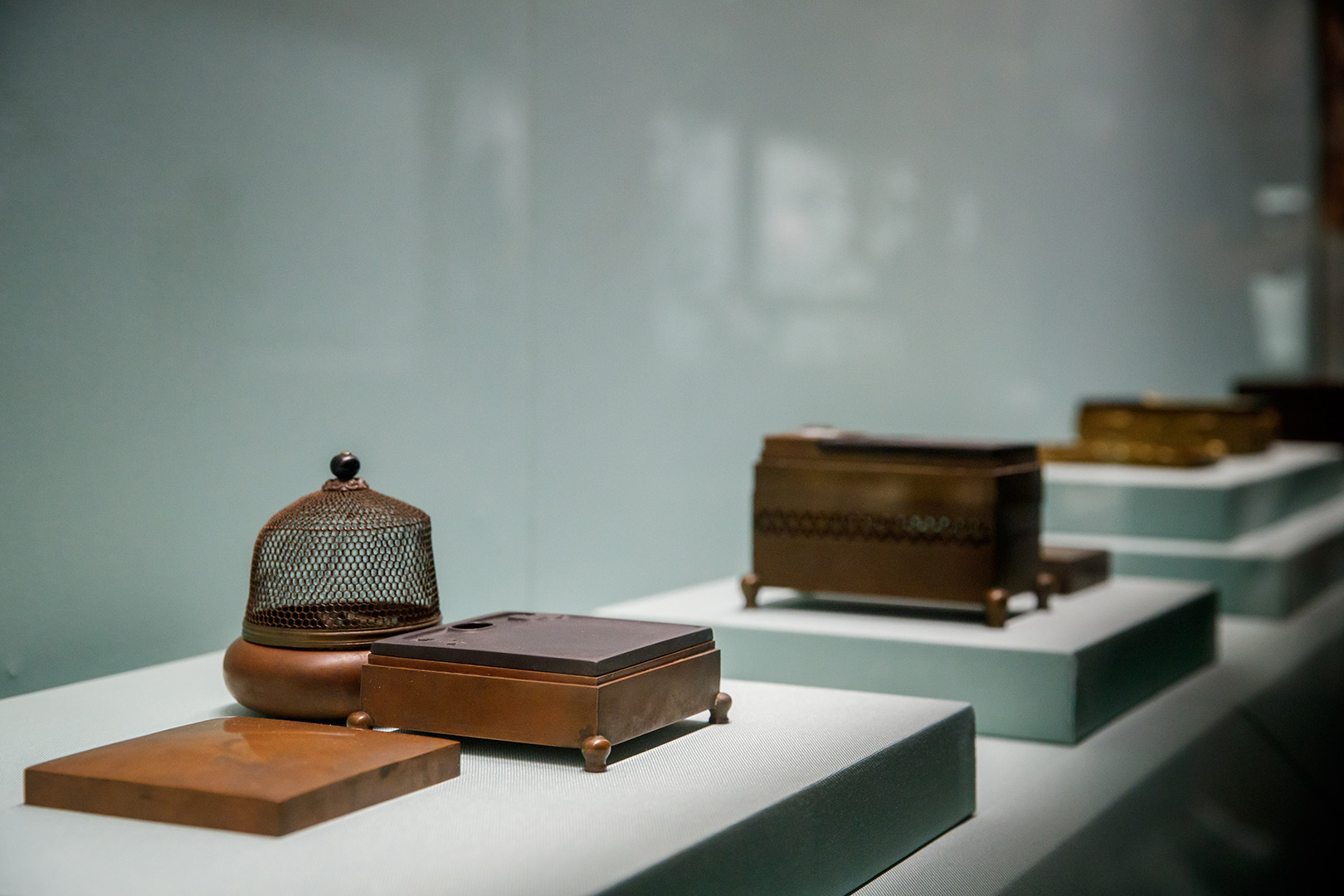
The Kangxi, Yongzheng, and Qianlong Emperors personally designed some of the inkstones they commissioned. For example, the Kangxi Emperor discovered Songhua stone on one of his eastern excursions to Mukden (present-day Shenyang) and ordered it to be quarried and sculpted into inkstones. The Yongzheng Emperor also enjoyed exquisite inkstones; he participated in designing warming inkstones with copper burners. After these two emperors innovated the design of inkstones, other emperors would continue in the tradition. As an avid connoisseur, the Qianlong Emperor designed a variety of inkstones with ancient and classical styles from the Han (206 BCE–220 CE), Tang (618–907), Song (960–1279), and Yuan (1271–1368) dynasties; some of his designs originated in the inkstone catalogues of Su Shi (1037–1101) and Gao Lian (1573–1620). The Qianlong Emperor also commissioned many inkstones with inscriptions of his poetry.
Imperial archives show how much of the production of inkstones made according to ancient styles during the Qianlong period were actually overseen by officials of the Suzhou textile manufactory and other large productions sites far from the capital. Others were presented as regional tribute by governors and other high officials. For instance, the governor of Anhui presented She inkstones, and the superintendent of Guangdong Customs presented Duan inkstones. Some officials presented materials for production, as in the case of Shanxi officials presenting fine clay.
Certain inkstones are marked with the names or titles of officials or the imperial household. Those articles with inscriptions such as “Imperially Appreciated by Jiaqing” (Jiaqing yushang) are characteristic of the period in which they were made or show how the imperial treasury added the mark of imperial appreciation to a piece from the old palace collection. Some of the inkstones from the Daoguang period were designed with warmers and have inscriptions denoting the practical use of the object.
During the Jiaqing and Daoguang reigns, the court proscribed or limited the presentation of tribute; these restrictions affected the making of new inkstones. As the era of Manchu rule waned, the production of inkstones declined. Few inkstones were made during the Tongzhi and Guangxu reigns, and, of those made, very few are considered quality works.
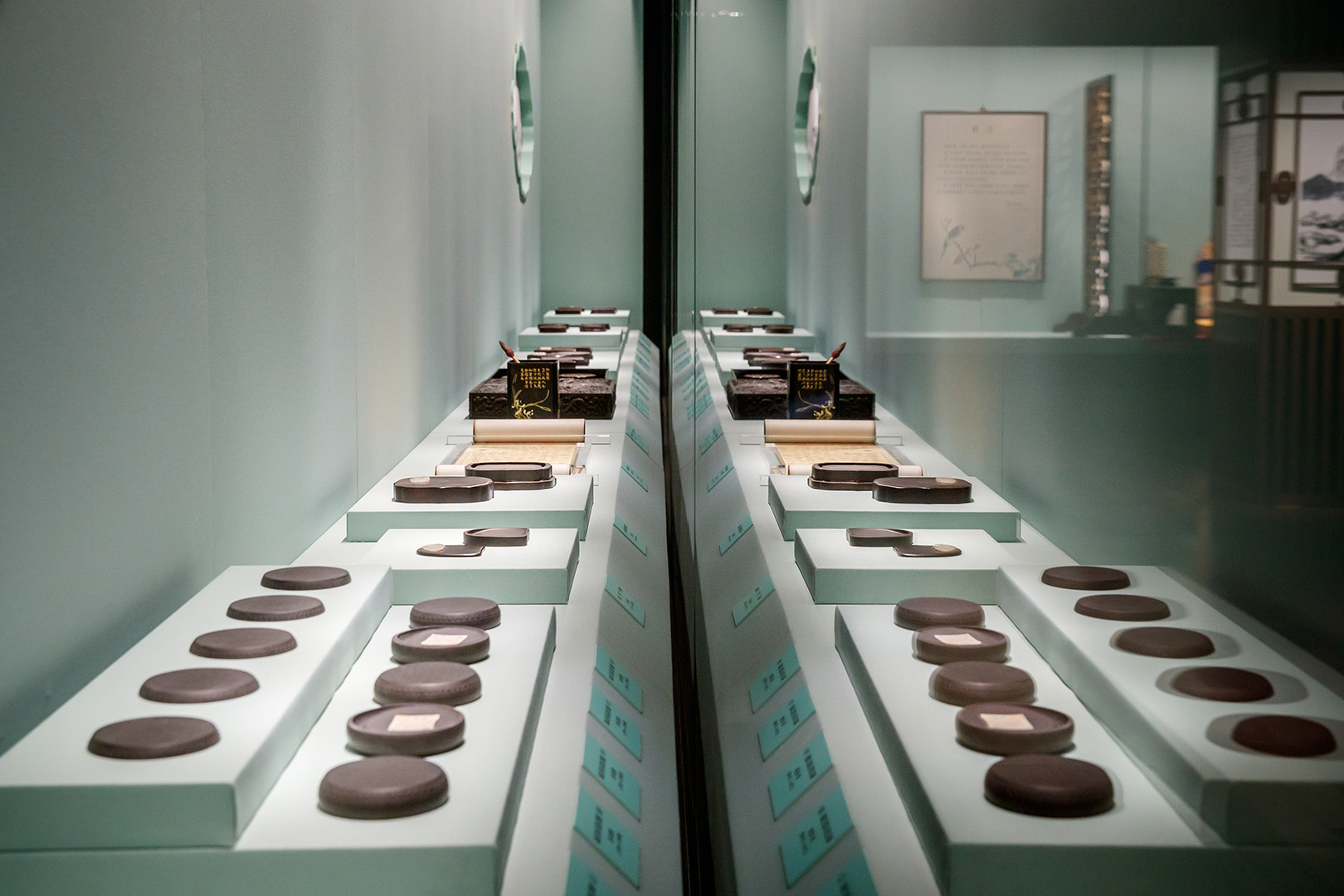
Songhua Inkstones
Songhua inkstones are made from Songhua stone, which is also known as Songhua jade and wula stone (lit. “river stone” from the Manchu ula, “river”). This material is found in the basin of the Songhua River near Changbai Mountain in northeast China; since it originates in the ancestral homeland of the Manchu people, the Qing court especially treasured the stone. Although found in a variety of green, yellow, purple, and black and with seams of various minerals, the highest quality Songhua stone is typically a shade of green. Beginning in the Kangxi reign, this stone was used to produce imperial inkstones; other high officials and members of the imperial clan were also granted the privilege to use such paraphernalia. After the middle of the Qianlong reign, the use of the stone was limited due to excessive quarrying.
Duan Inkstones
Duan inkstones are named after what was formerly called Duan Prefecture (present-day Zhaoqing, Guangdong Province) where the stone of the same name is found. From the mid-Tang period, the stone was quarried on a fairly large scale. The stone was used as tribute from the late-Tang to early-Song periods and was favored by literary scholars and the imperial family. Primarily greyish-black in tone, the stone is considered most valuable when found with a pink or purple tint. While most of the Duan inkstones used by the Qing court were produced by the imperial inkstone workshop, some were antique pieces from previous dynasties in the imperial collection or newly crafted for presentation as tribute.
She Inkstones
She inkstones are also known as Longwei inkstones (named after Mount Longwei, lit. “Dragon Tail Mountain”). Named after what was formerly known as She Prefecture (in the area of Mount Longwei of present-day Wuyuan, Jiangxi Province), the stone was first quarried in the Tang dynasty and became more heavily extracted in the Song dynasty. Often found with seams of mineral deposits, She stone is usually black or grey in color. Valued for its beauty and texture, the stone received praise by writers like the Song-dynasty literatus Su Shi. Due to the heavy quarrying during the Song dynasty, the stone became scarce. After the collapse of a She stone mine during the Yuan dynasty, quarrying the stone eventually ceased. Quarrying was revived during the Qing dynasty, and She inkstones were once again produced for use among the nobility.
Clay Inkstones
Clay inkstones are fashioned from fine, filtered clay. The finished product is a highly durable item for daily scholarly use. Used early on by calligraphers during the Tang dynasty, inkstones of this type were produced at well-known sites such as Jiang Prefecture (present-day Xinjiang, Shanxi Province) and Guo Prefecture (present-day Lingbao, Henan Province). During the Qianlong reign of the Qing dynasty, clay inkstones were often styled after ancient designs and made with material from the Fen River of Shanxi Province at imperially authorized workshops in Suzhou.
Jade Inkstones
The art of sculpting inkstones from jade began in the Han dynasty and was developed throughout Chinese history. These inkstones are fashioned from a variety of green, white, and black jade. The Song-dynasty artist Mi Fu (1051–1107) wrote of an inkstone he personally sculpted from green jade. Archaeologists have discovered jade inkstones among other grave goods in tombs of the Liao (907–1125), Yuan, and Ming (1368–1644) dynasties. Although these inkstones are prized for the lustrous beauty of the stone, they are less practical for calligraphers due to the less than optimal way in which the ink interacts with the surface of the jade as opposed to the more efficient inkstones made from clay or other stones. Consequently, these pieces have been used more often as ornamentation in scholarly studios. Jade inkstones of the Qing dynasty were made primarily in the imperial workshops, and certain antique pieces were inscribed in the Jiaqing reign to denote how they were personally appreciated by the Jiaqing Emperor.
Warming Inkstones
Warming inkstones were used in the winter to prevent the ink from freezing. Coal was used as the typical heating element. The earliest extant warming inkstones were made from clay and used in the Song dynasty. Various warming inkstones were used throughout the subsequent dynasties. These designs included tricolor styles in the Liao dynasty, jade in the Yuan, and metal in the Ming. In the Qing period, the imperial court used three types of warming inkstones, namely coal, coal and water, and stone-container warming inkstones. Typical coal warming inkstones were designed with a stone inkstone, coal burner, and copper case. The inkstones with coal and water included a stone inkstone, water tray, coal burner, and copper case. Stone-container warming inkstones were made of stone and designed with an open compartment for burning coal. In addition to these three main types, warming inkstones of the Qing period were made in many shapes and sizes and with exquisite ornamentation.
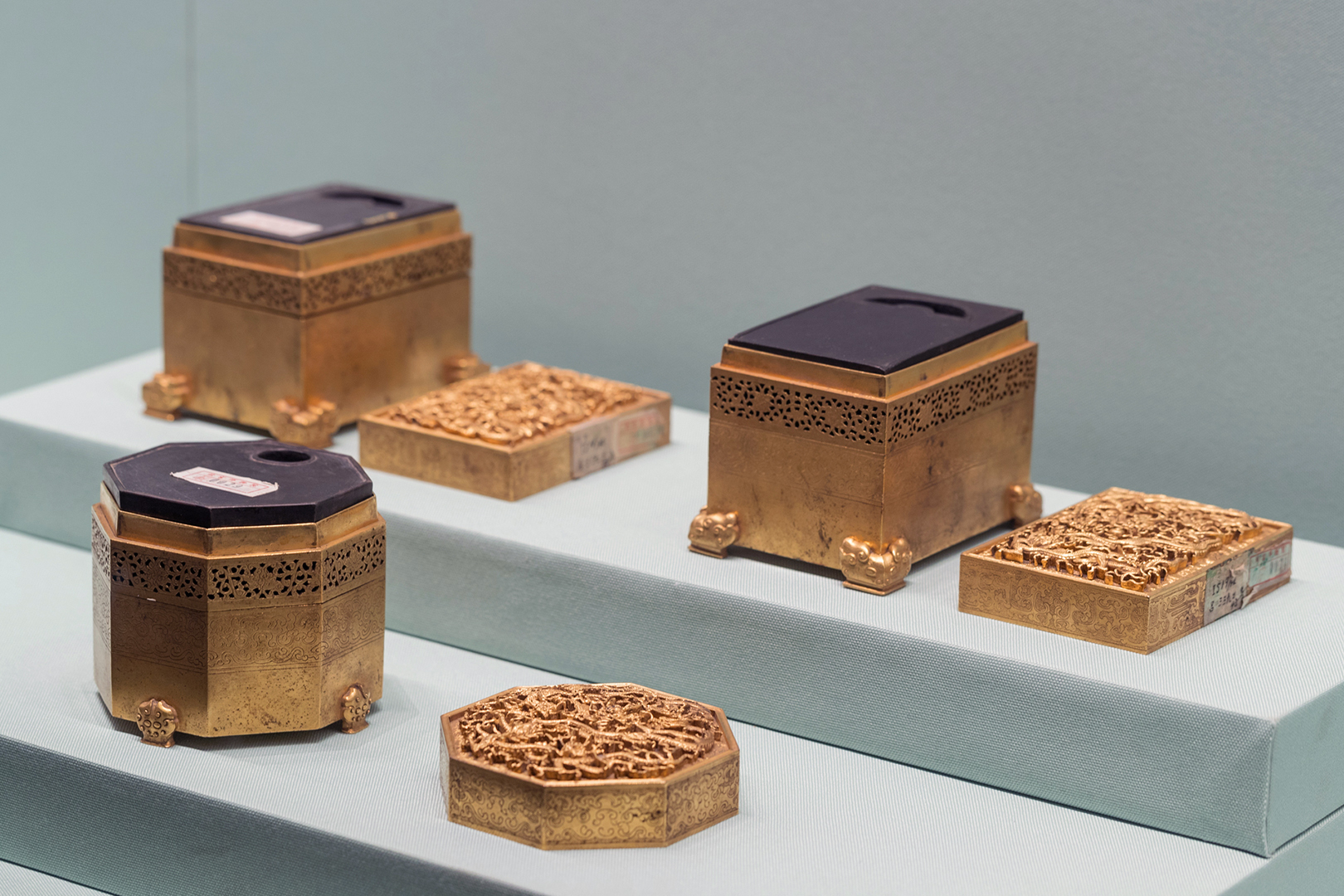
Inkstones with Poetry Inscriptions by the Qianlong Emperor
As an experienced art connoisseur, the Qianlong Emperor amassed an impressive collection of art and historical objects that included many inkstones. This emperor wrote over 300 poems regarding inkstones. He instructed his workshops to inscribe many of these poems onto inkstones; 240 of these pieces are listed in his imperially compiled Inkstone Catalogue of the Western Qing. Abounding in cultural significance, these works show the unique art with which the emperor surrounded himself and reveal his personal tastes and cultivated disposition. The quantity of extant pieces of the former imperial court are divided among the collections in Beijing and Taipei.
Studio Display
This display includes a black lacquer table with gold floral designs intended to sit atop a raised heated platform (called a kang). On the table rests an inkstone box, a jade inkstone, jade tablet inscribed with the preface to the imperial inkstone catalogue, brush, brush stand, and leaf of imperial calligraphy. The background is an image of the Qianlong Emperor.

Translated and edited by Adam J. Ensign and Zhuang Ying



